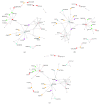Node-Structured Integrative Gaussian Graphical Model Guided by Pathway Information
- PMID: 28487748
- PMCID: PMC5405575
- DOI: 10.1155/2017/8520480
Node-Structured Integrative Gaussian Graphical Model Guided by Pathway Information
Abstract
Up to date, many biological pathways related to cancer have been extensively applied thanks to outputs of burgeoning biomedical research. This leads to a new technical challenge of exploring and validating biological pathways that can characterize transcriptomic mechanisms across different disease subtypes. In pursuit of accommodating multiple studies, the joint Gaussian graphical model was previously proposed to incorporate nonzero edge effects. However, this model is inevitably dependent on post hoc analysis in order to confirm biological significance. To circumvent this drawback, we attempt not only to combine transcriptomic data but also to embed pathway information, well-ascertained biological evidence as such, into the model. To this end, we propose a novel statistical framework for fitting joint Gaussian graphical model simultaneously with informative pathways consistently expressed across multiple studies. In theory, structured nodes can be prespecified with multiple genes. The optimization rule employs the structured input-output lasso model, in order to estimate a sparse precision matrix constructed by simultaneous effects of multiple studies and structured nodes. With an application to breast cancer data sets, we found that the proposed model is superior in efficiently capturing structures of biological evidence (e.g., pathways). An R software package nsiGGM is publicly available at author's webpage.
Figures
Similar articles
-
Joint Learning of Multiple Sparse Matrix Gaussian Graphical Models.IEEE Trans Neural Netw Learn Syst. 2015 Nov;26(11):2606-20. doi: 10.1109/TNNLS.2014.2384201. Epub 2015 Mar 4. IEEE Trans Neural Netw Learn Syst. 2015. PMID: 25751876
-
Joint Estimation of Multiple Conditional Gaussian Graphical Models.IEEE Trans Neural Netw Learn Syst. 2018 Jul;29(7):3034-3046. doi: 10.1109/TNNLS.2017.2710090. Epub 2017 Jun 28. IEEE Trans Neural Netw Learn Syst. 2018. PMID: 28678717
-
Learning Graphical Models With Hubs.J Mach Learn Res. 2014 Oct;15:3297-3331. J Mach Learn Res. 2014. PMID: 25620891 Free PMC article.
-
Structured Learning of Gaussian Graphical Models.Adv Neural Inf Process Syst. 2012;2012:629-637. Adv Neural Inf Process Syst. 2012. PMID: 25360066 Free PMC article.
-
Penalized estimation of sparse concentration matrices based on prior knowledge with applications to placenta elemental data.Comput Biol Chem. 2017 Dec;71:219-223. doi: 10.1016/j.compbiolchem.2017.10.012. Epub 2017 Nov 4. Comput Biol Chem. 2017. PMID: 29153892 Free PMC article.
Cited by
-
Transcriptional Networks of Microglia in Alzheimer's Disease and Insights into Pathogenesis.Genes (Basel). 2019 Oct 12;10(10):798. doi: 10.3390/genes10100798. Genes (Basel). 2019. PMID: 31614849 Free PMC article. Review.
-
Microbiome Multi-Omics Network Analysis: Statistical Considerations, Limitations, and Opportunities.Front Genet. 2019 Nov 8;10:995. doi: 10.3389/fgene.2019.00995. eCollection 2019. Front Genet. 2019. PMID: 31781153 Free PMC article. Review.
References
MeSH terms
LinkOut - more resources
Full Text Sources
Other Literature Sources




